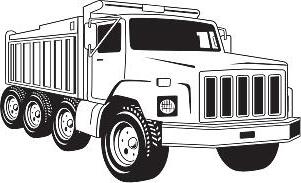




































By Jhyrah DeLapp Staff Writer
When people think of farming, they usually picture the planting, growing, and harvesting parts of the process. Rarely ever do people think about what farmers do during the winter.
Michigan is one of the most agriculturally diverse states, producing over 300 different agricultural commodities.
According to the Huron County Farm Bureau, Huron County has 440,967 acres of farmland, which represents 87% of the land in the county. That is the most farmland of any county in Michigan.
Huron County has the third highest market value of agricultural
products in Michigan with a $374,504,000 total. Farmers in Huron County have accomplished this by leading Michigan in the production of hay, wheat, sugar beets, cattle, dairy, and dry edible beans.
This level of production is possible because Huron County farmers rank second in value of crops including nursery and greens and value of livestock, poultry and their products.
The Huron County Farm Bureau has approximately 1,900 farming members.
Some farmers also grow crops during the winter months, like broccoli or spinach.
However, some also take this time as a reset to get ready for next year.
“So obviously the one thing that farm families do after a grueling harvest is take that little bit of time, about two weeks relax time,” Tim Fritz, of Farm Bureau Insurance in Huron County, said. “They start by doing inspections on their vehicles and equipment, ordering parts for equipment to work on over the winter time. Once they get the parts in, they can line up for any winter projects they may have. Then they power wash everything and put it away for the season.”
Frequently checking
parts and doing routine maintenance is an essential part of the whole process for farmers. It is important to ensure that equipment is in tip top shape to maximize production, and if it isn’t then farmers can order the proper replacement.
A lot of farmers also start their year-end bookkeeping during this time period after the harvest season.
This will allow them to properly assess the farm’s financial health by analyzing profitability and cost-efficiency of different processes. Yearend bookkeeping is also important for necessary tax compliance to make sure all policies and laws are being followed.
Proper year-end bookkeeping encourages farmers to have a budget plan, so if any unforeseen circumstances occur, they can properly pivot to the
Ser ving you from 8 locations: Bad Axe,Cass City Pinconning, Sebewaing, Unionville, Mayville, Caro, Ubly
correct alternative.
Once farmers have assessed their operations in totality, it allows for better informed decision making.
Fritz talked about the mindset farmers go through while looking over their inventory.
“They have to put a lot of work into planning what they’re going to do for next year to ensure everything goes smoothly,”
Fritz said. “Even though planting season is April or May, they are thinking, ‘What crops do they have to buy for next year? What seeds and fertilizers do we have to buy? Where am I going to store it? And how much do I need?”
If farmers don’t properly plan for the next year, it could result in profit loss or worse for the farm. So, it is essential they allocate enough time to ensure they have all the necessary materials because it could

result in delays in their schedule down the line.
Crop rotation and place is a vital part of planning for farmers to maintain soil fertility and prevent pests.
A good plan enables farms to optimize schedules and production, opening the door for investments because more time is being allotted to them.
One of the biggest pros of planning is damage mitigation. In all industries, especially agriculture, there will be unforeseen circumstances such as weather and market fluctuations. So, it is necessary to have processes in place to help bring stability when obstacles arise.
The work and planning farmers do during this time is essential and direct correlates to their success in the next year.







Agritourism is expected to grow past $60 billion globally this year. Your farm can get a piece of that pie by offering agritourism activities on your acreage.
Agritourism is a commercial enterprise that adapts agricultural production to entertain or educate visitors, generating income for the farm or ranch, the USDA says. Tourists represent increased profits, and agritourism gives farmers and ranchers the opportunity to educate the general public on where their food comes from.
According to the Penn State Extension, more than 50,000 farms in the U.S. reported at least part of $1 billion in profits as coming from agritourism.
Penn State says there are a variety of issues to consider before starting an agritourism business. There will be start-up costs, such as permits, extra labor and more. The farm or ranch will need to be made safe for the public at large, including around animals. You may need to check with your insurance provider about increased coverage.
Consider your comfort zone, Penn State says, especially if you live on the property. How big of a crowd can you comfortably handle? How will you manage things such as parking?
Check whether local zoning laws allow you to offer agritourism. There may be tax consequences if your property is in a program that lowers property taxes for agricultural use.
Agritourism turns your working farm or ranch into a tourist destination. Some ideas to get you started are corn mazes, pickyour-own fruits and vegetables, farmers markets, animal displays, fishing, bed and breakfasts and more. You can offer educational components, such as farm tours, seminars and camps. Whatever you offer, make sure it’s not competing with other local tourism opportunities. If someone offers a corn maze already, maybe consider a pumpkin patch. Create an operation that is eye-appealing, easy to navigate and safe. Post clear signage that is easy to read. Have a marketing plan for reaching potential customers. You may need to spend money on advertising.

Farm equipment is big in size and in budget. Luckily, there are ways to finance farm equipment that can help farmers get the heavyduty equipment they need.
The United States Department of Agriculture offers loan programs through the Farm Service Agency so farmers can get the financing they need to start, expand or maintain a family farm. Interest rates depend on the market, but are much lower than conventional bank loans. Native Americans are eligible for tribal loans through the FSA and those can also be used to buy equipment, as can emergency loans for farmers and ranchers recovering from natural disasters. FSA loans are either guaranteed loans or direct loans. Direct loans come from the FSA directly to the farmer, just as the name implies. Guaranteed loans are made by a USDA-approved
traditional lender with FSA backing.
The FSA offers loans to help farmers and ranchers implement climate-conscious practices and equipment. An example the USDA gives is a loan to purchase precision equipment such as strip till fertilizer equipment, no- or reduced-till equipment, livestock facility air scrubber or waste treatment, or fencing equipment installation. The USDA says up to $400,000 can be available for farm operating loans to cover the cost of such equipment.
The FSA also offers microloans up to $50,000 and EZ Guarantee Loans up to $100,000 to cover operating costs, including equipment. These loans are direct loans with a shortened application and reduced paperwork for loan amounts.
Eligibility requirements differ


from loan to loan. Some examples of eligibility requirements include U.S. citizenship with the legal capacity to obtain a loan, ability to show a good credit history and the training or experience to manage a farm or ranch effectively.
You may need a business plan describing financial and operational goals to help you evaluate progress. The plan demonstrates you’ve seriously thought about the future and that you understand all the parts of your proposed operation. The USDA suggests the plan include:
• A mission, vision and goals for your farm or ranch.
• Current assets and liabilities.
• What the farm or ranch will produce and how and where it will market and sell products.
• Whether the amount of income your operation will generate will be enough to pay living expenses.









Biodiesel is a renewable, biodegradable fuel manufactured from vegetable oils, animal fats or recycled restaurant grease. It can fuel internal combustion engines just like petroleum diesel, the Department of Energy says.
Use on the Farm or Ranch
Farmers and ranchers can use biodiesel on the farm and even produce it themselves.
Roger Rainville, a farmer in Vermont, can make biodiesel for about $1.70 per gallon. That’s in contrast to the average diesel price in 2024 of about $3.60 per gallon. Rainville grows canola seed and uses it to make canola meal for his cows as well as biodiesel.
About 100 pounds of oil or fat are mixed with an alcohol such as methanol to make 100 pounds of biodiesel and
10 pounds of glycerin or glycerol. Glycerin can be used to make pharmaceuticals or cosmetics.
Benefits of Biodiesel
Biodiesel use can reduce emissions, the Department of Energy says. Carbon dioxide released by the vehicle burning biodiesel is offset by growing the plants used to make the biodiesel. Furthermore, biodiesel in its pure form causes less damage than petroleum diesel if it’s spilled or otherwise released into the environment. Being less combustible, it’s also safer.
Using Biodiesel
Biodiesel is used as blends from B5 (5% biodiesel) up to B100, or pure biodiesel. Lowlevel blends, such as B5, are approved for safe operation in any vehicle that can run on traditional petroleum diesel.
Higher-level blends, such as B20, may not be approved by all manufacturers for use in conventional diesel vehicles (check with your vehicle’s manufacturer for details). B20 represents a good balance of cost, emissions, cold-weather performance and compatibility, the Department of Energy says. Higher-level blends may qualify for biodiesel fuel use credits.
Some states provide incentives for using biodiesel, such as tax breaks. Colorado, for instance, provides grants to promote biofuel usage. Georgia offers a tax credit for any business that manufactures alternative energy products for use in biofuel enterprises. Sales of personal property to an alternative fuel facility may be exempt from state sales and use tax.


Farm stays are another way to bring people closer to where their food comes from.
During a farm stay, people sleep overnight on a farm or ranch and experience the lifestyle for a day, a weekend or even more. Some farms give guests the opportunity to help with chores while others encourage guests just to relax and enjoy the peace and tranquility of country life.
The University of Vermont offers a 10-question assessment for deciding whether a farm stay program is right for your farm or ranch:
1. How comfortable are you talking with people you don’t know? Can you share your experience of what it’s like to be a farmer or rancher?
2. Can you see yourself as a host, educator, tour guide, reservation clerk, cook and maid? If not, do you know someone who can do some or all these things for you?
3. Do you know how your land is zoned? Can you build a cabin or cabins or add camping to your property? Have you spoken with the municipality about any regulations it has?
4. Do you have the cash to invest in a remodel, building or land grading, along with the furniture and amenities needed to host guests overnight?
5. Do you know how many nights you will need to be booked to break even or make a profit? What does your rate need to be?

6. Have you researched the competition, including what they charge, what they offer and how often they are booked?
7. Have you thought about your legal structure and what you might need to know about insurance?
8. Do you understand how the internet works and how to use it as a marketing tool?
9. Do you have any training in the hospitality or tourism industry? Do you understand what is and is not acceptable for travelers?
10. Have you included all family members living on the farm in the discussion? Is there a clear understanding of the commitment a farm stay will take in terms of time, energy and relationships? The university says to consider what things will set your farm stay apart and leave a lasting impression on your guests as well as what you can manage on a working farm or ranch. Think about how you can accept reservations.
Think about how your farm stay policies will affect both your life as a farmer or rancher and your guests, then set your rules accordingly.
Consider check-in and check-out times, breakfasts and other meals, a smoking policy, payment, cancellation policies, pets and children.
Check with the local and state Departments of Health for any other regulations your farm or ranch may need to meet. These could include land use permits or wastewater regulations.









